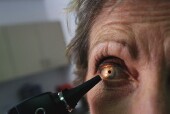
WEDNESDAY, July 22, 2015 (HealthDay News) — Eyes clouded by cataracts may one day be treated with drops rather than surgery, a new animal study suggests.
Today, surgery is the only means of treating cataracts, the leading cause of blindness in the world. Doctors extract cloudy lenses and replace them with artificial lenses.
But researchers have discovered that an organic compound called lanosterol can improve vision by dissolving the clumped proteins that form cataracts, said study lead author Dr. Kang Zhang, chief of ophthalmic genetics with the Shiley Eye Institute at the University of California, San Diego.
Eye drops containing lanosterol completely cleared the vision of three dogs with naturally occurring cataracts after six weeks of treatment. The drops improved vision for four other cataract-afflicted dogs, according to findings published July 22 in the journal Nature.
“The results we have point to a new nonsurgical treatment of cataracts that can be used for people who might have moderate cataracts or do not have access to surgery,” Zhang said.
These findings “point to a new direction in cataract research,” at a time when there’s huge pressure to come up with a better way of treating cataracts, said Dr. J. Fielding Hejtmancik, a senior investigator at the U.S. National Eye Institute (NEI).
The aging of the baby boom population is expected to fuel a huge increase in cataracts, since most occur as part of the aging process, Hejtmancik said.
It’s already occurring. Between 2000 and 2010, cases of cataracts in the United States rose 20 percent, from 20.5 million to 24.4 million, according to the NEI. By 2050, that number is expected to double to an estimated 50 million.
Cataract surgery is a safe and routine procedure, but demand will rise dramatically. “You’re going to probably double your surgical requirements within the next 10 years,” Hejtmancik said.
Lanosterol eye drops could provide a cheaper and easier alternative for cataract treatment in many people, and perhaps prevent cataracts in someone at risk for developing them, Zhang and Hejtmancik said.
“The nice thing about cataracts is, you can detect them long before they become a problem to the person who has them,” Hejtmancik said. “When you do an eye exam, you see some haziness and you know that’s the beginnings of a cataract. That gives you a way to screen individuals, say when they’re 50.”
Cataracts occur when the normally clear crystallized proteins that form the eye’s lens begin to clump together, blurring or clouding vision. Damage from aging and exposure to ultraviolet light usually promotes this clumping, Hejtmancik said.
“Proteins in the lens don’t turn over. The proteins you have in the center of your lens were there before you were born, and time damages things,” Hejtmancik said.
The human body normally uses lanosterol to synthesize cholesterol and steroid hormones, but researchers have found that high concentrations of lanosterol also are present in the eye’s lens, Zhang said.
Lab tests showed that lanosterol could prevent cataract-causing proteins from clumping together in a petri dish. Lanosterol also cleared up cataracts in lenses dissected from 13 lab rabbits.
As a final test, Zhang and his team tested the drops on seven dogs with cataracts. All responded to the treatment, with either partial or total clearing of their cataracts.
“To me, that’s quite a convincing chain of evidence,” said Hejtmancik, who wrote an editorial accompanying Zhang’s study. “He’s moved through the test tube right up through cultured cells to a living animal.”
Zhang said he hopes to begin human testing with lanosterol within two years. Results of animal experiments aren’t always replicated in humans, however.
Also, Hejtmancik warned that other researchers are more skeptical, and want to see a more detailed analysis of Zhang’s process.
“I view this as opening a door, and pointing eye research and cataract research in a new direction,” he said. “I don’t think we’re going to be curing cataracts by December.”
More information
For more about cataracts, visit the U.S. National Eye Institute.
Copyright © 2025 HealthDay. All rights reserved.

